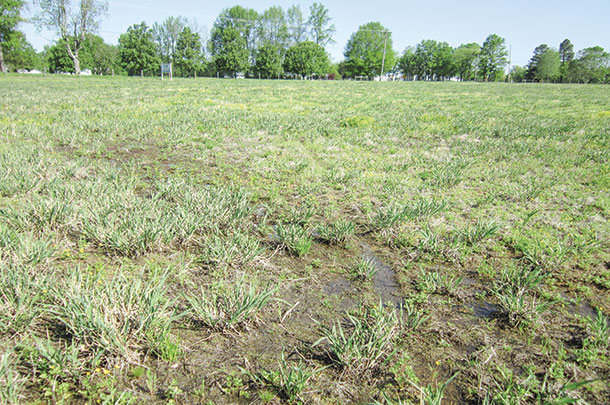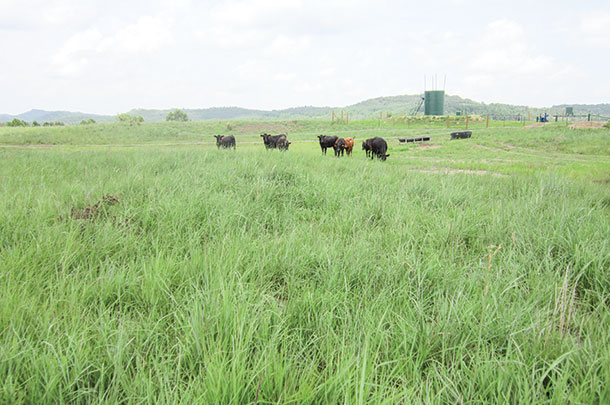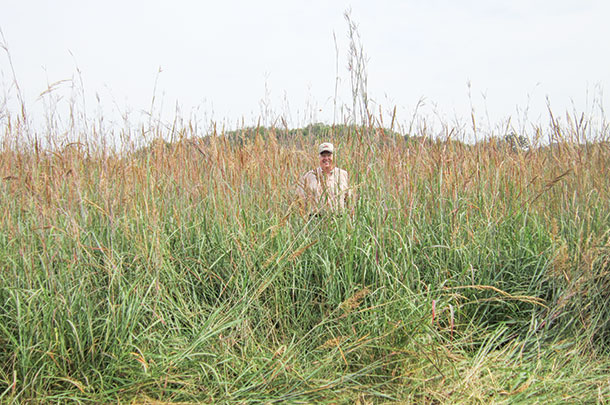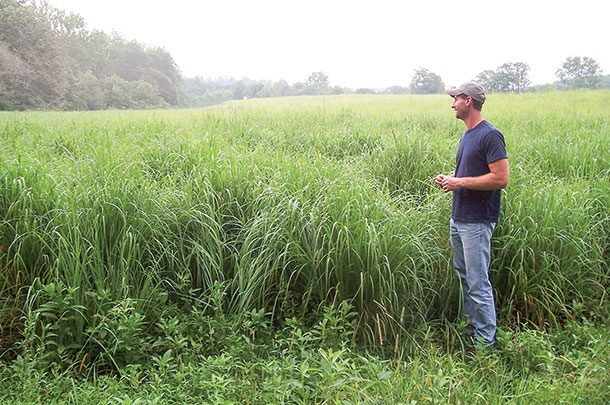On the other hand, I hear they are “always better than non-native grasses,” “produce 10 tons of forage per acre” or “they should replace all of our other grasses.” Between these very positive and very negative perceptions, what are the facts? Based on several years of research conducted at University of Tennessee (UT), here are some facts concerning what producers can expect from native grass forages.
Adaptability
Because they are native to most of the U.S. east of the Rockies, species such as big bluestem, indiangrass and switchgrass are well adapted to a wide variety of conditions in these areas. Some grow better in one kind of site than another – “lowland” varieties of switchgrass can grow in extremely wet sites, indiangrass and little bluestem can grow on very poor sites.
If you take care to match the species and variety to the site, you can indeed grow native grasses about anywhere on your farm you can reasonably manage for forage (Photos 1a and 1b).


Keep in mind though, despite this adaptability, natives will, like any other grass, produce better on better sites and worse on poor sites. In an ongoing study in Kentucky and Tennessee, big bluestem/indiangrass pastures on reclaimed surface mines (very poor sites) can carry only about 40 percent of the stocking of average pasture ground.
Similarly, a UT study in west Tennessee found that although switchgrass can grow on very wet sites, yield was depressed (about 75 percent of that on well-drained soils) on such sites. Nevertheless, natives typically can outperform many of our other options on these marginal sites.
Establishment
Are natives tough to establish? Yes and no. On one hand, the ones we are mostly interested in from a forage production standpoint are perennials. Like all perennials, seeds are small, germination is slow and seedling vigor is often low. And, like all perennials, successful establishment depends on good competition control – and timely rain.
Where competition control is excellent (even just very good) and rainfall is adequate, very good stands of native grasses can be established with reasonably high reliability (Photo 2).

In establishing more than 90 experimental pastures over the past decade, we have had a success rate on the first attempt of nearly 80 percent with equal proportions of failures due to excessive weed pressure and extreme drought. In planting over 5,000 acres of switchgrass over three years in east Tennessee, the success rate on first attempts was more than 90 percent.
A comment about time for establishment is worth making here. With good moisture and weed control, you can expect to have a well-established stand the first summer. Do not graze or hay it that first growing season. The following spring, you can safely graze or take a single hay cutting.
However, keep in mind that natives continue to develop their very deep root systems (8 to 12 feet) throughout the second year, so it is very important not to push the stand too hard during the second year. A well-established second-year stand of big bluestem and indiangrass will produce about 2.5 tons per acre of hay – a figure comparable to typical cool-season hayfields in normal annual production in the mid-South. In the third year, you can expect full production.
Longevity
So now that we have established a native grass stand, how long can we expect it to last? As with any grass, management will have a great deal to do with the answer to that question. With good management (not repeatedly overgrazing), it would not be unreasonable to expect a stand to last 15 or 20 years.
I have known producers who have had switchgrass stands last as many as 20 years. Can they last longer? I do not know, but clearly, native grasses have persisted in one form or another on this continent for millennia. On the other hand, continued close defoliation can mean a lifespan as short as five years.
Drought tolerance
Like other summer grasses, native warm-season grasses have what is known as a C4 metabolic pathway. What that means for you is greater water-use efficiency than what can be provided by cool-season species (C3 metabolism) such as tall fescue and orchardgrass. So when it comes to surviving summer drought, you really need to include a C4 species in your program.
Among warm-season options, annuals may not be a good choice since establishment may be a problem depending on when the dry weather sets in. Too, prussic acid and nitrate issues may be a concern with annuals. Fortunately, natives do not have those issues. Also, data from drought studies have demonstrated that natives have greater water-use efficiency than bermudagrass, the other widely used perennial summer grass in the region.
Thus, when it comes to putting yourself in a position to withstand tough summer drought, natives are one of the best tools available to cattlemen.
Yield
Yield for native grasses depends on what variety, species and site you are dealing with. Some natives (e.g., Highlander eastern gamagrass and Alamo switchgrass) have very high yields, 5 to 6 tons per acre with about 60 units of nitrogen on average sites. On the other hand, on marginal sites with no fertilizer (more on that in a later issue), species such as little bluestem may produce less than 2 tons per acre.
Many studies conducted on native prairies in the Great Plains report fairly low yields relative to studies in the Southeast. Part of the explanation for those differences is that stands in the Plains are on sites unsuitable for row crop production – in other words, marginal sites. Furthermore, they are in areas with considerably lower rainfall than what we receive in the Southeast.
By comparison, in the Southeast on typical sites and with precipitation greater than 40 inches annually, it is reasonable to expect an average of about 4 tons per acre for big bluestem and indiangrass, about 5 tons for lowland switchgrass and eastern gamagrass (Photo 3).
 Based on the facts above, it is clear that natives provide a relatively long-lived, very drought-tolerant, summer forage tool. They can be planted on a wide variety of sites and generally produce good yields. On the other hand, establishment requires good to excellent competition control and foregone production during the seedling year.
Based on the facts above, it is clear that natives provide a relatively long-lived, very drought-tolerant, summer forage tool. They can be planted on a wide variety of sites and generally produce good yields. On the other hand, establishment requires good to excellent competition control and foregone production during the seedling year.
Do they make sense for you? That is a decision each producer must evaluate, preferably based on good science and not simply opinions that may be based on no data or misinformation.
In a subsequent issue, we will explore a number of additional important issues related to native grass forages including input requirements, animal performance, grazing management, winter forage production and use of prescribed fire.
You can also find additional information regarding native grass forages at UT Extension (Institute of agriculture, native grass forages). ![]()
PHOTO 1: Natives are adapted to a wide variety of conditions including very wet sites, such as where this stand of eastern gamagrass has been established.
PHOTO 2: Very poor sites, such as big bluestem/indiangrass pasture on a reclaimed surface mine in eastern Kentucky.
PHOTO 3: Native grasses have earned a reputation for being difficult to establish. However, with good advanced competition control and adequate rainfall, an excellent stand can be established. Here, a big bluestem/indiangrass/little bluestem pasture was planted in late April, and the photo was taken five months later in September.
PHOTO 4: In the eastern U.S., where rainfall typically exceeds 40 inches annually, native grasses on average sites can produce large volumes of forage. Here, a big bluestem stand shows why yields of 4 to 5 tons per acre are possible. Photos by Pat Keyser.

-
Patrick Keyser
- Professor and Director of Center for Native Grasslands Management
- University of Tennessee Institute of Agriculture
- Email Patrick Keyser






